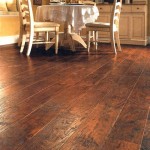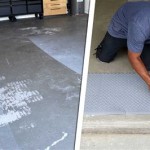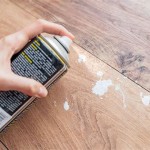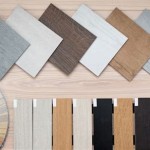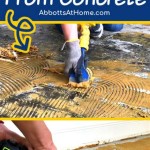Best Ways to Remove Carpet Adhesive From Wood Floor
Removing carpet adhesive from a wood floor represents a common challenge for homeowners and contractors undertaking renovation projects. The adhesive, designed for strong bonding, often leaves a stubborn residue that can damage the wood if improperly addressed. A meticulous and patient approach, utilizing the appropriate tools and techniques, is required to effectively remove the adhesive without compromising the integrity of the wood flooring.
The success of adhesive removal hinges on understanding the type of adhesive used, the type of wood flooring, and the potential impact of various removal methods. This article outlines various approaches to removing carpet adhesive from wood floors, providing a comprehensive guide to ensure the best possible outcome.
Understanding the Adhesive and the Wood
Different types of carpet adhesives exist, each possessing unique chemical properties and bonding strengths. Common types include water-based adhesives, solvent-based adhesives, and epoxy adhesives. Water-based adhesives are generally easier to remove compared to their solvent-based counterparts. Epoxy adhesives, known for their exceptional strength and durability, pose the greatest challenge.
Identifying the adhesive type is crucial for selecting the appropriate removal method. Labels on remnants of the old carpet or adhesive containers, if available, can provide this information. If identification is not possible, a process of experimentation, starting with the mildest methods, is recommended to avoid damaging the wood.
The type of wood flooring also significantly influences the selection of removal techniques. Hardwood floors, such as oak, maple, and hickory, are more resilient and can withstand more aggressive methods compared to softer woods like pine or fir. Engineered wood floors, with their veneer layer, are particularly susceptible to damage and require careful handling.
Prior to commencing any adhesive removal process, testing a small, inconspicuous area is essential. This allows for assessing the impact of the chosen method on the wood finish and surface, minimizing the risk of large-scale damage.
Mechanical Removal Methods
Mechanical removal involves physically scraping or sanding the adhesive from the wood surface. While effective, these methods require precision and control to prevent gouging or scratching the wood. The effectiveness of mechanical removal also depends on the type and age of the adhesive. Older, brittle adhesives are often easier to remove mechanically compared to newer, more pliable ones.
A floor scraper, equipped with a sharp, angled blade, is a primary tool for mechanical removal. Holding the scraper at a low angle, applying consistent pressure, and working with the grain of the wood are crucial for preventing damage. The blade should be regularly sharpened to maintain optimal cutting performance.
For smaller areas or stubborn adhesive residues, a putty knife or chisel can be used. These tools offer greater control and precision, allowing for targeted removal. However, caution must be exercised to avoid digging into the wood surface.
Sanding can be employed as a secondary method to remove any remaining adhesive residue and smooth out the wood surface. An orbital sander or a drum sander, depending on the scale of the project, can be used. Start with a coarse-grit sandpaper (e.g., 60-grit) to remove the bulk of the residue, followed by progressively finer grits (e.g., 80-grit, 100-grit, 120-grit) to achieve a smooth finish. Dust collection is essential during sanding to maintain a clean work environment and prevent respiratory irritation.
Dust masks and eye protection are mandatory when engaging in mechanical removal methods to protect against airborne particles and debris.
Chemical Softening and Removal Methods
Chemical solvents can soften the adhesive, making it easier to scrape away. A variety of solvents are available, each with varying degrees of effectiveness and safety considerations. Selecting the appropriate solvent depends on the type of adhesive and the wood flooring.
Mineral spirits, a relatively mild solvent, are often effective for removing water-based adhesives. They are also less likely to damage wood finishes compared to stronger solvents. Apply mineral spirits liberally to the adhesive residue, allowing it to soak for several minutes to soften the adhesive. Then, use a scraper or putty knife to remove the softened adhesive. Multiple applications may be necessary for stubborn residues.
Acetone, a stronger solvent, can be used for removing solvent-based adhesives. However, acetone can damage certain wood finishes and should be used with caution. Test acetone in an inconspicuous area before applying it to the entire surface. Apply acetone sparingly and work quickly, as it evaporates rapidly.
Commercial adhesive removers, specifically formulated for carpet adhesive removal, are also available. These products typically contain a blend of solvents and surfactants designed to break down adhesive bonds. Follow the manufacturer's instructions carefully when using these products. Ensure adequate ventilation and wear appropriate personal protective equipment, such as gloves and a respirator.
Regardless of the solvent used, thorough ventilation is crucial to prevent the buildup of harmful vapors. Open windows and doors, and use fans to circulate air. Avoid prolonged exposure to solvent vapors.
After removing the softened adhesive, clean the wood surface with a damp cloth to remove any remaining solvent residue. Allow the wood to dry completely before applying any new finish or sealant.
Heat Gun Method
A heat gun can be used to soften the adhesive, making it easier to scrape away. The heat weakens the adhesive bond, allowing for easier removal. However, excessive heat can damage the wood or ignite flammable materials. Therefore, careful application and control are essential.
Set the heat gun to a low or medium setting. Hold the heat gun several inches away from the adhesive residue and move it slowly back and forth. Avoid concentrating the heat on one spot for too long. The goal is to soften the adhesive, not to burn it.
As the adhesive softens, use a scraper or putty knife to remove it. Work quickly and efficiently, as the adhesive will re-harden as it cools. Multiple passes with the heat gun may be necessary for stubborn residues.
Exercise extreme caution when using a heat gun near flammable materials, such as curtains, furniture, or cleaning solvents. Keep a fire extinguisher nearby as a safety precaution.
After removing the adhesive, allow the wood to cool completely before cleaning or sanding it. The heat can temporarily soften the wood, making it more susceptible to damage.
Steam Method
Steam can be used to soften some types of carpet adhesive, particularly water-based varieties. The steam penetrates the adhesive, breaking down its bond with the wood. This method is generally less aggressive than chemical solvents or heat guns, making it a suitable option for delicate wood floors.
Use a steam cleaner or a handheld steamer to apply steam to the adhesive residue. Hold the steam nozzle close to the adhesive, allowing the steam to penetrate for several seconds. The duration of steam application will depend on the type and thickness of the adhesive.
As the adhesive softens, use a scraper or putty knife to remove it. Work in small sections, applying steam and scraping away the softened adhesive. Multiple passes with the steamer may be necessary.
After removing the adhesive, wipe the wood surface with a dry cloth to remove any excess moisture. Allow the wood to dry completely before applying any new finish or sealant. It is crucial to prevent water damage to the wood floor.
The steam method is most effective on water-based adhesives. Solvent-based or epoxy adhesives may require alternative methods or a combination of methods.
Post-Removal Procedures
After removing the carpet adhesive, the wood floor may require further treatment to restore its original appearance. This may involve sanding, staining, and sealing. The specific procedures will depend on the condition of the wood and the desired outcome.
Sanding is often necessary to smooth out any imperfections caused by the adhesive removal process. Start with a medium-grit sandpaper (e.g., 80-grit) to remove any scratches or gouges, followed by progressively finer grits (e.g., 100-grit, 120-grit) to achieve a smooth finish. Dust collection is essential during sanding.
Staining can be used to restore the original color of the wood or to change its appearance. Choose a stain that is compatible with the type of wood and the existing finish. Apply the stain evenly and allow it to dry completely before applying a sealant.
Sealing protects the wood from moisture, wear, and tear. Choose a sealant that is appropriate for wood floors, such as polyurethane or varnish. Apply multiple coats of sealant, allowing each coat to dry completely before applying the next.
Proper ventilation is essential during sanding, staining, and sealing to prevent the buildup of harmful vapors. Wear appropriate personal protective equipment, such as gloves, a respirator, and eye protection.

Flooring How Can I Remove Carpet Adhesive From Hardwood Floors Home Improvement Stack Exchange

Removing Glue Or Adhesive From Hardwood Floors The Speckled Goat

How To Remove Carpet Glue From Wood Concrete Floors Ultimate Diy Guide

How To Remove Glue From Wood Floors Pete S

How To Remove Carpet Glue Goo Gone

How To Remove Carpet Glue And Floor Adhesive View Our Tips

Easy Ways To Get Rid Of Carpet Tape On Wooden Floors Or Stairs Floor Sanding

Wood Flooring Sentinel S

Removing Parquet Flooring Floor Adhesive Lessons Learned Life After 40

Remove Floor Mastic Adhesive Without Damaging Hardwood
See Also
